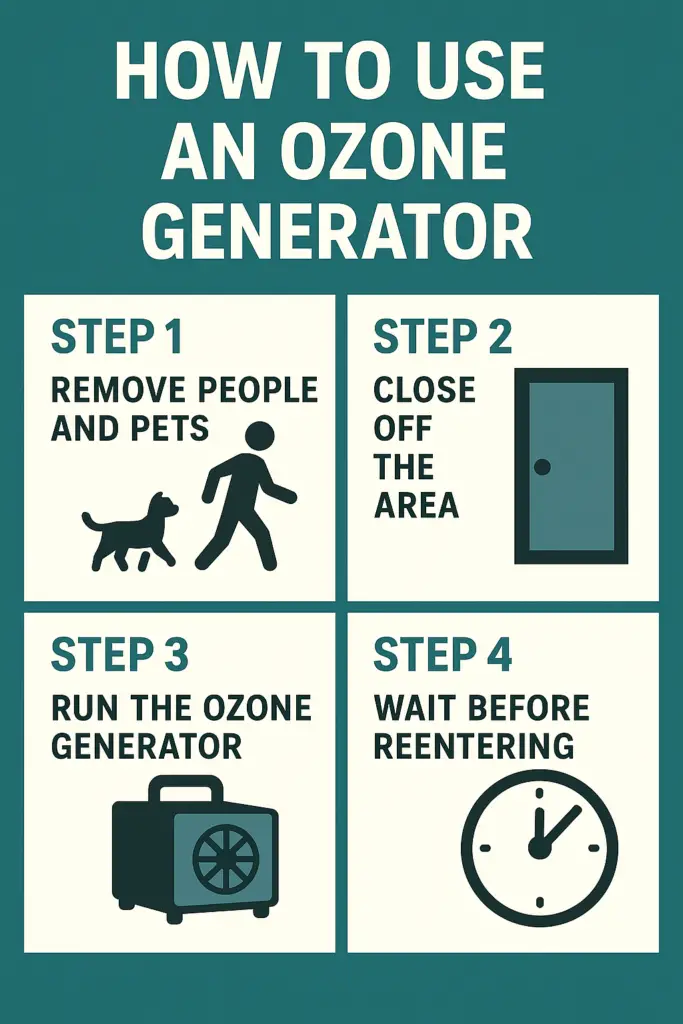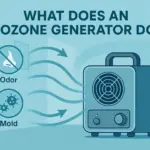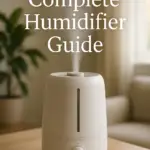To ozone a house safely and effectively, remove all people, pets, and plants, clean surfaces first, and run the generator with a timer in a sealed room. Let the ozone fully dissipate (30–90 minutes) before re-entering, and never use it as a substitute for cleaning or mold removal. When used correctly, ozone can eliminate strong odors, sanitize air, and restore freshness — but misuse can be harmful and counterproductive.
Table of Contents
Ozoning a House: A Powerful Tool — If You Know the Rules
Ozone generators are often misunderstood. Some people swear by them for removing stubborn odors, while others warn about health risks and ruined furniture. The truth is somewhere in between: ozone can be a powerful home treatment tool — but only when used with care and precision.
In this guide, we’ll walk through the proven do’s and don’ts of ozoning a house. You’ll learn exactly how to prep your space, run the generator safely, and avoid the most common mistakes that lead to poor results or long-lasting smells. We’ll also dive into which odors ozone can actually remove, when it works (and when it doesn’t), and how to choose the right size generator for your needs.
Whether you’re tackling cigarette smoke, musty odors, or rental property cleanup, this step-by-step guide will show you how to use ozone the right way — and get your home smelling fresh again without causing damage or danger.
How to Use an Ozone Generator at Home Safely

Using an ozone generator isn’t like running an air purifier or setting up a fan. Ozone is powerful and potentially hazardous if misused. To keep things safe, follow these specific steps every time you use it. These are the non-negotiables.
Step 1: Evacuate the Area
Ozone is not safe to breathe — even in small doses over time. Always make sure the treatment area is completely free of:
- People
- Pets (including fish tanks!)
- Houseplants
If you’re treating a whole home, everyone must leave during the treatment and stay out during the dissipation period.
Step 2: Seal the Room
Close all windows and interior doors. You want to contain the ozone within the treatment area so it can concentrate on the problem — not leak into the rest of the house. Cover HVAC vents if needed to keep ozone from spreading into your duct system.
Step 3: Set a Timer
Most generators have a built-in timer. If yours doesn’t, plug it into a wall timer so it automatically shuts off. This is crucial for safety — you should never enter the room just to turn the machine off. A typical cycle is 30 minutes to 2 hours depending on room size and odor strength.
Step 4: Post-Treatment Wait Time
After the generator shuts off, don’t rush back in. Ozone doesn’t just disappear instantly. Give it:
- 30–60 minutes to break down in a small, well-ventilated space
- 2–4 hours in large rooms or with high-output units
Ozone naturally converts back to oxygen, but the timing depends on airflow and how much was used. Crack windows and use a fan if you need to speed things up.

Step 5: Re-Enter and Ventilate
Once it’s safe, re-enter the room and open windows and doors to flush out any lingering ozone. A portable fan blowing outward can help. If the room smells sharp or sterile (like chlorine), wait longer — that’s the ozone.
Bonus: Safety Signage
Consider taping a sign like “DO NOT ENTER — OZONE TREATMENT IN PROGRESS” on each entry point to the treated area. This is especially important in shared spaces, multi-unit homes, or rental properties where others may not be aware of the ozone treatment.
Even just 5 minutes of ozone exposure can cause irritation to the lungs, eyes, and throat. A clear warning helps prevent accidental entry and keeps everyone safe.
Getting the Best Results From an Ozone Generator
Ozone generators can be incredibly effective — but only if used strategically. Just plugging one in and hoping for the best often leads to weak results or, worse, an overpowering ozone smell that lingers. Here’s how to dial in your process and get the most value from each treatment.
1. Match the Generator Size to the Space
A common mistake is using an ozone machine that’s either too weak to work or so strong that it creates overkill. Use a unit sized appropriately for the room you’re treating. For example:
- ✅ 500–1,000 mg/hr for cars, bathrooms, and closets
- ✅ 3,000–5,000 mg/hr for bedrooms or small apartments
- ✅ 10,000+ mg/hr for large living spaces or full homes
Too little ozone won’t neutralize odors. Too much means longer wait times and potential ozone side effects. When in doubt, start small and scale up gradually.
2. Clean First — Ozone Is Not Magic
Ozone works by breaking down odor-causing molecules, but it won’t cut through layers of dust, food grease, or pet hair. Always prep your space:
- ✅ Vacuum carpets and rugs
- ✅ Mop or wipe down floors
- ✅ Dust hard surfaces and baseboards
A cleaner room allows ozone to interact directly with odors instead of getting absorbed by surface grime.
3. Place the Generator Strategically
Don’t just drop the machine in a corner. Center it in the room if possible. If the room is large or oddly shaped, consider elevating it on a table or chair to help ozone circulate more evenly. Ozone is heavier than air, so a raised position can help it spread before settling.
4. Go Low and Slow First
If this is your first time using a machine, resist the urge to crank it up. Start with a low setting and short runtime (e.g., 30–45 minutes) and evaluate the results. You can always re-treat if the smell remains.
Overuse is a common issue. Too much ozone can create side effects like plastic smell, ozone haze, or VOC reactions with materials in the home.
5. Repeat for Stubborn Odors
Deep-set odors like smoke or mildew may require multiple treatments. It’s better to do 2–3 short sessions with ventilation in between than one long blast that oversaturates the air. “If you’re dealing with pests instead of odors, ozone won’t help. See the full guide on ozone and bed bugs.”
With proper planning and prep, ozone becomes a precise tool — not a blunt instrument. These extra steps often make the difference between “meh” and “wow.”
How to Pick the Right Size Ozone Generator

Getting the size right isn’t just about results — it’s about safety. A generator that’s too small won’t neutralize odors. One that’s too big might leave ozone lingering for hours and cause damage to fabrics, rubber seals, or electronics.
Understand Ozone Output Ratings
Ozone machines are typically rated in milligrams per hour (mg/hr) — this tells you how much ozone they produce. The higher the number, the faster and more aggressively the ozone fills a space.
Here’s a rough guide for matching output to space size:
| Area Treated | Recommended Output |
|---|---|
| Cars / Bathrooms / Closets | 500–1,000 mg/hr |
| Bedrooms / Small Offices | 1,000–3,000 mg/hr |
| Living Rooms / Large Rooms | 5,000–7,000 mg/hr |
| Whole Homes / Heavy Odor Jobs | 10,000–15,000 mg/hr+ |
Why “Bigger Is Not Always Better”
You might be tempted to buy the most powerful unit available and just “let it rip.” But that can backfire:
- Excess ozone takes much longer to break down
- It increases the risk of damage to materials (rubber, plastic, upholstery)
- It can lead to chemical reactions with VOCs, creating unwanted byproducts
Instead, aim for the minimum effective dose. Start on a lower setting and shorter time span. If odors persist, you can always repeat the process or increase exposure gradually.
Portable vs. Professional Units
Some consumer ozone generators are meant for cars and small rooms only — they max out under 1,000 mg/hr. Mid-range units often include timers, handles, and replaceable ozone plates. Large professional units are meant for entire homes or serious smoke damage, but they must be handled with caution.
If you’re deciding whether to rent or buy an ozone machine before treating your home, see my guide on when renting an ozone machine makes sense and when buying is cheaper
Need Help Choosing?
We’re building a dedicated sizing guide with examples and room calculators. Until then, follow the chart above and always test cautiously.
👉 New article:How to Pick the Right Ozone Generator for Your Space
Before-and-After Ozone Checklist
If you want the best results from ozone — and to avoid common mistakes — preparation is key. Here’s a field-tested checklist you can follow every time you run a treatment. It’s simple, repeatable, and proven to work.
✅ Before You Turn It On
- Clean the space. Vacuum carpets, sweep and mop floors, and wipe down dusty surfaces. Ozone works best when it’s not competing with layers of grime.
- Remove living things. Take out people, pets, houseplants, and even fish tanks. Cover or remove food and any valuable or sensitive materials.
- Close doors and vents. Seal off the treatment area to contain the ozone. Close HVAC vents and use painter’s tape or towels to block air leaks if necessary.
- Use a timer. Set the generator to shut off automatically. This is especially important if you won’t be nearby.
- Post a sign. Hang a warning on each entrance to prevent accidental entry. Something simple like “⚠️ DO NOT ENTER — OZONE TREATMENT IN PROGRESS” works great.
✅ After It Turns Off
- Wait it out. Even after the machine shuts off, let ozone break down fully. This usually takes 30–90 minutes. For large rooms or high settings, wait 2–4 hours.
- Ventilate thoroughly. Open windows and doors, turn on fans, and flush the room with fresh air. This speeds up the breakdown and clears any lingering smell.
- Do a walkthrough. Smell the air. If it still smells strongly of ozone (sharp, metallic, or bleach-like), wait longer before re-entering fully.
- Repeat if needed. If odors are still noticeable the next day, it’s okay to run a second treatment. Just go slow and ventilate each time.
With a good routine, ozoning a room becomes safe, efficient, and surprisingly simple.
Final Thoughts: Ozone Is Powerful — Respect It
Ozone generators aren’t miracle machines, but when used correctly, they can transform musty, smoky, or stale-smelling spaces into clean, fresh environments. The key is preparation, sizing, safety — and knowing when ozone is the right tool for the job.
Don’t expect ozone to fix mold problems, pest infestations, or deep cat urine damage. But for neutralizing airborne odors and refreshing a space after a flood, tenant turnover, or smoke exposure — few things work better. On going, day to day issues are better solved with UV air purifiers and HEPA in your HVAC.
Start small, ventilate well, and always stay on the safe side. That’s how you get great results without putting your health or home at risk.
Next up: Learn how to choose the right ozone generator for your home — with room-by-room breakdowns, pro tips, and model comparisons.






